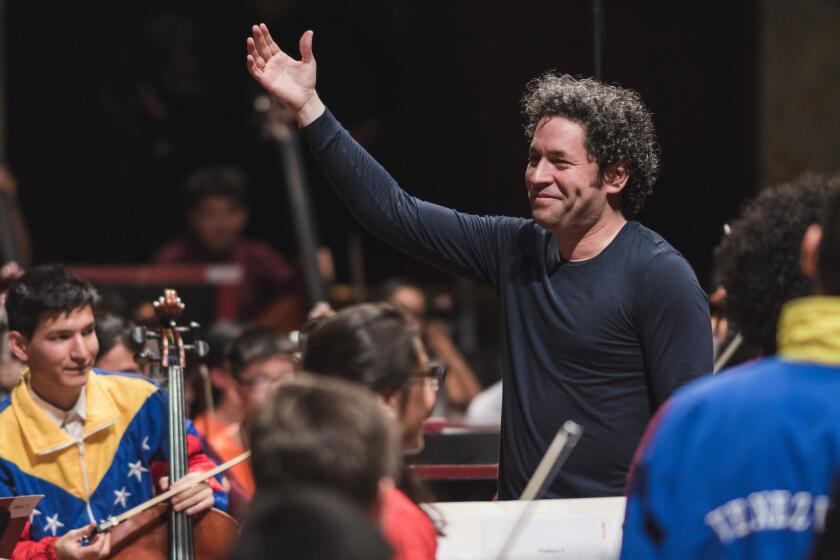The golden age of Sammy
- Share via
Sammy Davis Jr. was a jack of all entertainment trades and master of them all. He could sing, dance, do impressions, conduct and even sling a gun with the virtuosity of Billy the Kid. He was also a man tormented by inner demons.
His versatility and vulnerability are on display in the Museum of Television & Radio’s new two-part screening series, “Sammy in the Sixties: The Television Work of Sammy Davis Jr.,” which begins today and continues through April 6.
“Golden Boy of Broadway,” which screens tonight through Feb. 27, includes a long-lost 1964 episode of the public television series “American Musical Theatre” and the final episode of his short-lived 1966 NBC musical-variety series, “The Sammy Davis Jr. Show.”
“London and More,” screening Feb. 28 through April 6, includes a 1963 concert taped at BBC studios, Davis’ segment from the 1965 “Frank Sinatra Spectacular,” a benefit concert in St. Louis, and two excerpts from the “Sammy Davis Jr. Show” including a camp classic with Davis, Elizabeth Taylor and Richard Burton performing “What Do the Simple Folk Do?”
Davis, who died of cancer at 64 in 1990, was at the peak of his vocal powers during this period highlighted in the series, says museum curator Rebecca Paller.
Audiences today remember the 5-foot, 3-inch African American performer mainly as a member of the Rat Pack, “or they think of him in the ‘70s and ‘80s when he became more flashy,” Paller says. “He would be on talk shows and was very exuberant and loaded down with jewelry and all kinds of catch phrases.”
These performances from 1963-66 capture “his ideal blend of humanity and showmanship,” Paller says. “Everything came together, his struggling years in show business in the late ‘40s and early ‘50s. Everything led him to his moment when he was so fabulous. As a singer and a dancer he could do no wrong.”
Born in Harlem in 1925, Davis began performing at age 5 and made his film debut in 1933 in the musical short “Rufus Jones for President.” He finally hit stardom in the ‘50s, first as a member of the Will Mastin Trio, then as a Broadway performer in the 1956 musical “Mr. Wonderful.” He was one of the few performers who did their own singing in the 1959 movie version of “Porgy and Bess,” playing the flamboyant Sportin’ Life. As a member of the Rat Pack along with Sinatra, Dean Martin, Peter Lawford and Joey Bishop, Davis appeared with the group in Las Vegas, as well as in such films as “Ocean’s Eleven” and “Robin and the Seven Hoods.”
Perhaps his greatest triumph was in the 1964-66 Charles Strouse-Lee Adams musical, “Golden Boy,” for which he received a Tony nomination for his performance as a prizefighter trying to box his way out of Harlem.
During the Broadway engagement, Davis cut records, did his own series, appeared in concert and made the movie “A Man Called Adam.”
“He was very representative of a time and place,” says Strouse, who appears with Davis on the “American Musical Theatre” installment.
“He was created from a lot of forces, like the Earth coming in and ‘whoop,’ here comes Sammy Davis.”
Strouse found Davis to be a very complex man. On the one hand, Strouse noted, “He was brilliant along with everything else. He was the biggest star of his day and in the theater he had no peer. We sold out all the time.”
And yet, because Davis was stretched so thin during this period, Strouse says, he ended up missing several performances of “Golden Boy.”
“He got himself very tired or perhaps depressed or nervous,” he says. Davis extended himself “the way lemmings go to the edge of the cliff and then they go off. He didn’t go off, but he was always on the end of the cliff. I know he smoked a great deal, but I also think he drank a good deal, but I could never prove it. He was very driven and yet very mild-mannered and almost submissive to Sinatra.”
As a performer, Strouse says, Davis “had to be loved. He wouldn’t get off the stage.”
Whatever his personal demons were, Paller says, they certainly didn’t manifest themselves in these performances.
“He rose to challenges you didn’t think he could rise to,” says Paller. “When he did the ‘American Musical Theatre,’ he was extremely tired that day and said before the program, ‘I am not going to be singing.’ Then all of a sudden he said, ‘Let’s do a song from the show.’ It was like Sammy was so energized.... He wanted to sing. He would give his all and more.”
NBC gave Davis his own variety series at a time when African Americans were still few and far between on network shows. Davis’ series, though, lasted only 16 weeks. Critics had lambasted the first installment that featured Taylor and Burton, and the show never recovered. On the finale, Davis is quite literally the entire show -- singing, dancing, doing bits from his nightclub act and even joking around with a Sammy Davis Jr. puppet.
One of the most intriguing moments from the finale finds Davis lip-syncing to Robert Preston’s recording of “Trouble” from “The Music Man.”
“It’s not just a small child in a living room putting on a cast recording dancing around,” says Paller, “he’s really into it and offering his own take on this con man. It’s almost eerie hearing Bob Preston’s voice coming from Sammy, but there’s something moving about it.”
*
‘Sammy in the Sixties: The Television Work’
Where: Museum of Television & Radio, 465 N. Beverly Drive., Beverly Hills
When: Tonight through April 6. Screening times, 2 p.m. Wed.-Sun. and 7:30 p.m. Thurs.
Price: Suggested contribution is $10 for adults, $8 for senior citizens and students, $5 for children under 14
Information: (310) 786-1000 or go to www.mtr.org
More to Read
The biggest entertainment stories
Get our big stories about Hollywood, film, television, music, arts, culture and more right in your inbox as soon as they publish.
You may occasionally receive promotional content from the Los Angeles Times.











